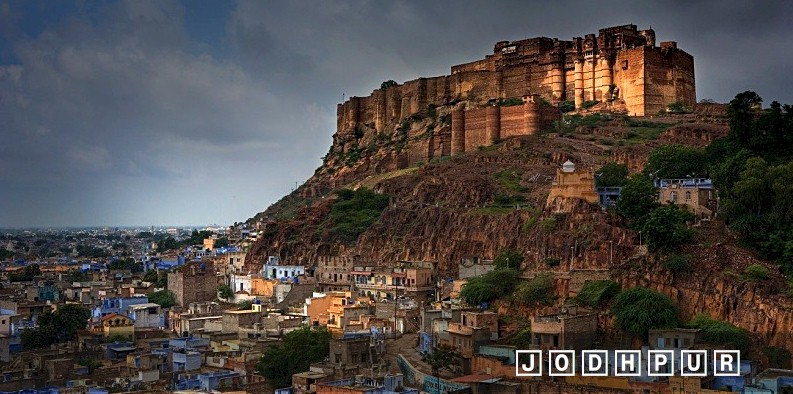Rajasthan Vacation Tour -
Golden splendor amid the desert
Jaisalmer – the golden beauty, etched in yellow sandstone. Perched atop the Trikuta Hill, it stands tall against miles of gleaming sand. Epitomising the desolate, awesome charm of the desert.
Jaisalmer, the city of the golden fort is a fantasy in yellow sandstone in the heart of the Thar Desert. The city was founded in 1156 by Rawal Jaisal, a Bhatti Rajput King.
Legend has it, that Lord Krishna – the head of Yadav Clan, foretold Arjuna that a remote descendent of Yadav Clan would build his kingdom atop the Trikuta Hill. His prophecy was fulfilled, when in 1156 AD Rawal Jaisal, a descendant of Yadav Clan and a Bhatti Rajput, founded the city of Jaisalmer.
This amber-hued city, in the heart of the desert, dazzles gloriously in the early morning. The sunset has a peculiar glow here. As the night descends, the sky goes up in flames, which fade leaving a few embers, till it becomes black. A breathtaking sight indeed!
Jaisalmer is famous for cobbled streets, strewn with palaces, forts, temples and havelis. Every house, here, is exquisitely carved, having filigreed work all over. These houses date back to 12th – 15th century. And hence Jaisalmer is called 'the Museum city'.
Filled with colour, festivity and smiles, Jaisalmer is truly a memorable experience across the shimmering sands.
Air: The nearest airport is Jodhpur (285 km)
Rail: Jaisalmer is connected with Jodhpur by night train service.
Road: Well connected by road with all the major cities of India. Direct bus services to Udaipur, Mount Abu, Jodhpur, Bikaner, Barmer, Ajmer and Jaipur. Ahmedabad and Bhuj (Gujarat),
What to see
Jaisalmer Fort :Renew yourself amid the past galore, as you visit the commanding Jaisalmer Fort. The fort stands guard over the desertscape from its 250 feet high perch on the hill with its wall following the contours of the hills.
Gadsisar Lake :A rain water lake, adorned with an arched gateway. Many small shrines and temples are festooned a11 around the lake. Today, it is an ideal picnic spot, famous for boating.
Salim Singh-ki-Haveli : Witness the legendary architectural wealth of Jaisalmer at Salim Singh's haveli, truly unsurpassed in splendor. Of particular note are the blue roof and rows of peacocks below the arched balconies. The haveli was once the residence of the Mohta family, ministers of Jaisalmer rulers.
Nathmalji-ki-Haveli : This haveli was carved by two brothers. One worked on right side and the other on left, but the harmony in design exists still. Screened windows, projected balconies and intricate carvings illustrate superb craftsmanship.
Jain Temples : Within the citadel are the splendorous Jain temples, dedicated to Rishabdevji, Sambhavnathji and Parshvanathji.

Excursions
Devikot (40 kms), Ramdeora (150 kms), Sam Sand Duna (42 kms), Lodhruva (17 kms), Bada Bagh (6 kms), Wood Fossil Park (17 kms), Desert National Park (40 kms), Barmer (153 kms).
Altitude: 225 mtrs.
Best Season: Oct - Feb
Climate: Summer
Mean Max. 47.0 'C
Mean Min. 35.0 'C
Winter Mean Max. 20.0 'C
Mean Min. 2.0 'C
Clothing: Summer light tropical or cotton Winter Woolen.
Distances from Jaisalmer :
Delhi 884 Kms.
Agra 853 Kms.
Ajmer 513 Kms.
Alwar 782 Kms.
Bharatpur 828 Kms.
Jaipur 645 Kms.
Jaisalmer - Kms.
Jodhpur 305 Kms.
Mt. Abu 572 Kms.
Ranthambhore 786 Kms.
Welcome Rajasthan Travel & Tourism Services
Shop No- 51, First Floor,
Arcade International Complex,
Civil Line, Ajmer Road,
Jaipur, Rajasthan, India - 302006
Phone No : 91-141-4108278
Mobile : +91-98290-14553 / +91-98292-14575
Telefax : +91-141-5103085
Email : info@rajasthantraveltrip.com, a1toursindia@gmail.com
Website : www.rajasthantraveltrip.com
Labels: Rajasthan Tour & Travel Packages, Rajasthan Tour Guide, Rajasthan Tour Packages, Rajasthan Tour Trip, Rajasthan Travel Agent















.jpg)







.jpg)
.jpg)
.jpg)
.jpg)
.jpg)

.jpg)
.jpg)
.jpg)
.jpg)

